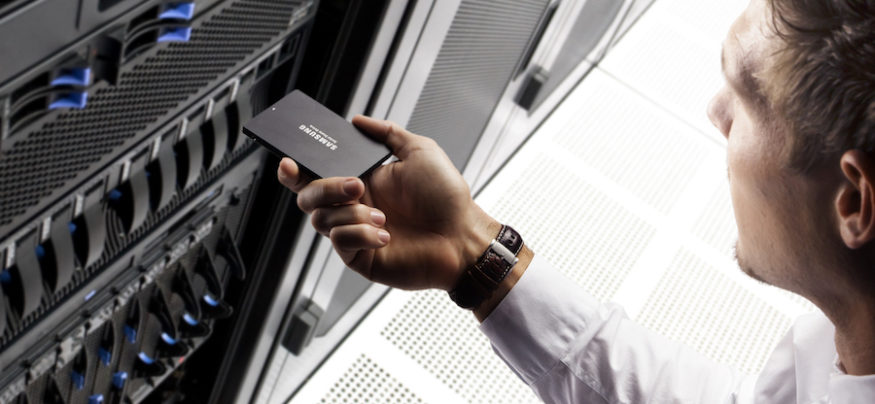With the change from hard disk drives (HDDs) to solid state drives (SSDs), one of the most basic questions that comes to mind for new buyers is: Why is SSD better than HDD?
Here’s a look at the difference.
What Is an SSD?
To best understand an SSD, it helps to describe a traditional HDD first. These legacy drives are made up of platters covered in magnetic material that spin at high speeds. Mechanical arms with read and write heads can access all of the available spaces on each platter and write the ones and zeroes. Hard drives of this sort are available in all shapes and sizes, and they differ based on their capacities, the interface bus type they use to connect to the host computer, how quickly they seek and read data off the mechanical platters, and how many revolutions per minute at which the drive platters spin.
Understanding SSD Endurance and Over-Provisioning
Get your free guide to optimizing SSD over-provisioning for improved cell endurance. Download Now
If you imagine replacing all of the spinning and mechanical pieces of the traditional hard drive with memory, much like RAM in your computer, then you have the basics of an SSD. Instead of spinning platters, you have layers of solid-state memory that store data in pages and keys. This means that access to data, for either reading or writing, is much faster than having a drive spin-up, followed by mechanical heads attempting to physically locate a specific sector on a platter. If you played with RAM disks in the 1990s and 2000s, then the SSD is the natural evolution of that idea into a production-quality drive.
SSD Reliability
The lack of the mechanicals — all the spinning, and all of the motion of the heads on the arms — raises the question, is an SSD more reliable than a legacy drive? The answer is an unequivocal yes, for a couple of reasons:
- Without moving parts, the SSD is immune to most physical shocks, making them well suited for devices that are on the move a lot, including laptops.
- There is nothing mechanical to wear out — no motors to break — on an SSD, making the life expectancy dependent on the ability of the memory to continue to store electrical signals — and that can be a very long time.
SSD Costs
When SSDs were first available on the market, they were very expensive compared to traditional HDDs in a couple of ways: They started out at higher costs regardless of capacity, but also priced per megabyte or gigabyte. The flash memory was more expensive for manufacturers to source, acquire and condition, but as SSDs have become more popular, the demand has driven prices down not only as a whole but also comparatively against the capacity-adjusted price of traditional HDDs. In addition, higher capacity SSDs — in the 960GB to 1TB range — are now available, whereas in the past, to get those capacities, you had to purchase a traditional disk drive.
While traditional hard drives are still cheaper than SSDs for now, the performance and longevity benefits of SSDs have never been as inexpensive as they are today, and prices overall between the two favor SSDs for many operations. If you consider their superior reliability and longer life spans, the total cost of ownership of an SSD, depending on your environment, may well be lower than a traditional hard drive, despite the higher initial cost of acquisition.
When Is an SSD the Right Choice?
For situations where performance is the most crucial and other factors are secondary, there’s no better choice than an SSD. Other situations where SSDs are the right choice:
- For business or corporate laptops, or for systems that could take a lot of physical abuse or encounter shocks, the reliability of the SSD will trump a traditional disk drive.
- For faster performance in heavy read situations, such as in a database environment, the SSD’s maximum read rate far surpasses a traditional hard drive.
- In environments where heat and noise can be a factor, SSDs are essentially silent and produce very little heat, as opposed to a traditional drive which has the sound of the platters rotating, as well as the seek heads reading and writing data.
- In limited battery life situations, SSDs draw minimal power compared with the current hungry needs of mechanical drives, making them well-suited for portables.
Better Performance Turns Into Money
Consider the case of an office worker whose fully burdened cost to a company approaches $120 for every work hour. Each day, the employee waits five minutes for her computer to boot up. That’s a $10 cost every single day of lost productivity. If that employee is able to reduce a five-minute computer startup to under a minute, over a typical 260-day work year, that’s more than $2,000 in productivity savings just by implementing an SSD.
In another case, suppose you’re paying a video editor $150 every hour he works for you, and with your current legacy drive system, he’s idle half the time waiting for videos to render. If you can cut video render times by up to 70 percent, as some Samsung case studies have proven, that could translate into $75, $90, even $105 worth of savings per rendering hour just on personnel alone. The savings can be staggering.
Samsung is a premier manufacturer of NAND, the flash memory medium used within SSDs. Samsung drives are designed to be reliable and high-performing from the start, engineered to exacting specifications, and come with aggressive and competitive warranties to ensure confidence in your purchase.
Not sure where to start? Take this assessment to see which SSD is best for your enterprise deployment.








